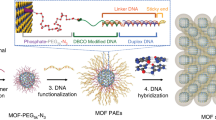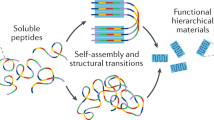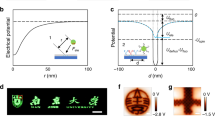Abstract
In biological systems, organic molecules exert a remarkable level of control over the nucleation and mineral phase of inorganic materials such as calcium carbonate and silica, and over the assembly of crystallites and other nanoscale building blocks into complex structures required for biological function1,2,3,4. This ability to direct the assembly of nanoscale components into controlled and sophisticated structures has motivated intense efforts to develop assembly methods that mimic or exploit the recognition capabilities and interactions found in biological systems5,6,7,8,9,10. Of particular value would be methods that could be applied to materials with interesting electronic or optical properties, but natural evolution has not selected for interactions between biomolecules and such materials. However, peptides with limited selectivity for binding to metal surfaces and metal oxide surfaces have been successfully selected10,11. Here we extend this approach and show that combinatorial phage-display libraries can be used to evolve peptides that bind to a range of semiconductor surfaces with high specificity, depending on the crystallographic orientation and composition of the structurally similar materials we have used. As electronic devices contain structurally related materials in close proximity, such peptides may find use for the controlled placement and assembly of a variety of practically important materials, thus broadening the scope for ‘bottom-up’ fabrication approaches.
This is a preview of subscription content, access via your institution
Access options
Subscribe to this journal
Receive 51 print issues and online access
$199.00 per year
only $3.90 per issue
Buy this article
- Purchase on Springer Link
- Instant access to full article PDF
Prices may be subject to local taxes which are calculated during checkout




Similar content being viewed by others
References
Belcher, A. M. et al. Control of crystal phase switching and orientation by soluble mollusc-shell proteins. Nature 381, 56– 58 (1996).
Falini, G. et al. Control of aragonite or calcite polymorphism by mollusk shell macromolecules. Science 271, 67– 69 (1996).
Cha, J. N. Silicatein filaments and subunits from a marine sponge direct the polymerization of silica and silicones in vitro. Proc. Natl Acad. Sci. USA 96, 361–365 (1999).
Meldrum, F. C., Mann, S., Heywood, B. R., Frankel, R. B. & Bazylinski, D. A. Electron microscopy study of magnetosomes in two cultured vibrioid magnetotactic bacteria. Proc. R. Soc. Lond. B 251, 238–242 ( 1993).
Colvin, V. L., Goldstein, A. N. & Alivisatos, A. P. Semiconductor nanocrystals covalently bound to metal surfaces with self-assembled monolayers. J. Am. Chem. Soc. 144, 5221–5230 (1992).
Brust, M., Bethell, D., Schiffrin, D. J. & Kiely, C. J. Novel gold-dithiol nano-networks with nonmetal electronic properties. Adv. Mater. 7, 795–797 ( 1995).
Li, M., Wong, K. K. W. & Mann, S. Organization of inorganic nanoparticles using biotin-streptavidin connectors. Chem. Mater. 11, 23– 26 (1999).
Alivisatos, A. P. et al. Organization of ‘nanocrystal molecules’ using DNA. Nature 382, 609–611 (1996).
Mirkin, C. A., Letsinger, R. L., Mucic, R. C. & Storhoff, J. J. A DNA-based method for rationally assembling nanoparticles into macroscopic materials. Nature 382, 607– 609 (1996).
Brown, S. Engineered iron oxide-adhesion mutants of the Escherichi coli phage λ receptor. Proc. Natl Acad. Sci. USA 89, 8651–8655 (1992).
Brown, S. Metal-recognition by repeating polypeptides. Nature Biotechnol. 15, 269–272 ( 1997).
Parmley, S. F. & Smith, G. P. Antibody-selectable filamentous Fd phage vectors- affinity purification of target genes. Gene 73, 305–318 ( 1988).
Swaminathan, V. & Macrander, A. T. Materials Aspects of GaAs and InP Based Structures (Prentice Hall, Englewood Cliffs, New Jersey, 1991).
Acknowledgements
We thank D. Margolese, D. Morse and G. Stucky for discussions, and H. Reese, J. English and R. Naone for providing semiconductor substrates. We acknowledge the use of the core microscopy facilities in the Texas Materials Institute (SEM). We also thank the Institute of Molecular and Cellular Biology (TEM) at the University of Texas at Austin. We acknowledge the assistance of the NSF-sponsored National Nanofabrication Users Network in providing some of the structures for this project. This work was supported by ARO/DARPA (S.R.W and A.M.B), a DuPont Young Investigator Award (A.M.B.), the NSF (P.F.B. and E.L.H.) and the Robert A. Welch Foundation (P.F.B. and A.M.B.). This work was also funded by faculty start-up funds provided by the University of Texas at Austin (A.M.B.).
Author information
Authors and Affiliations
Corresponding author
Rights and permissions
About this article
Cite this article
Whaley, S., English, D., Hu, E. et al. Selection of peptides with semiconductor binding specificity for directed nanocrystal assembly. Nature 405, 665–668 (2000). https://doi.org/10.1038/35015043
Received:
Accepted:
Issue Date:
DOI: https://doi.org/10.1038/35015043
This article is cited by
-
Effect of hydrophobic groups on adsorption of arginine-based amino acids to solid surfaces in water
Structural Chemistry (2023)
-
M13 Bacteriophage-Based Bio-nano Systems for Bioapplication
BioChip Journal (2022)
-
A minimalistic cyclic ice-binding peptide from phage display
Nature Communications (2021)
-
Molecular recognition and specificity of biomolecules to titanium dioxide from molecular dynamics simulations
npj Computational Materials (2020)
-
Preparation of Silver-Coated Silica Microspheres with High Electrical Conductivity Through Pyrogallol-Fe(Ш) Coordinated Surface Functionalization
Journal of Inorganic and Organometallic Polymers and Materials (2020)
Comments
By submitting a comment you agree to abide by our Terms and Community Guidelines. If you find something abusive or that does not comply with our terms or guidelines please flag it as inappropriate.



